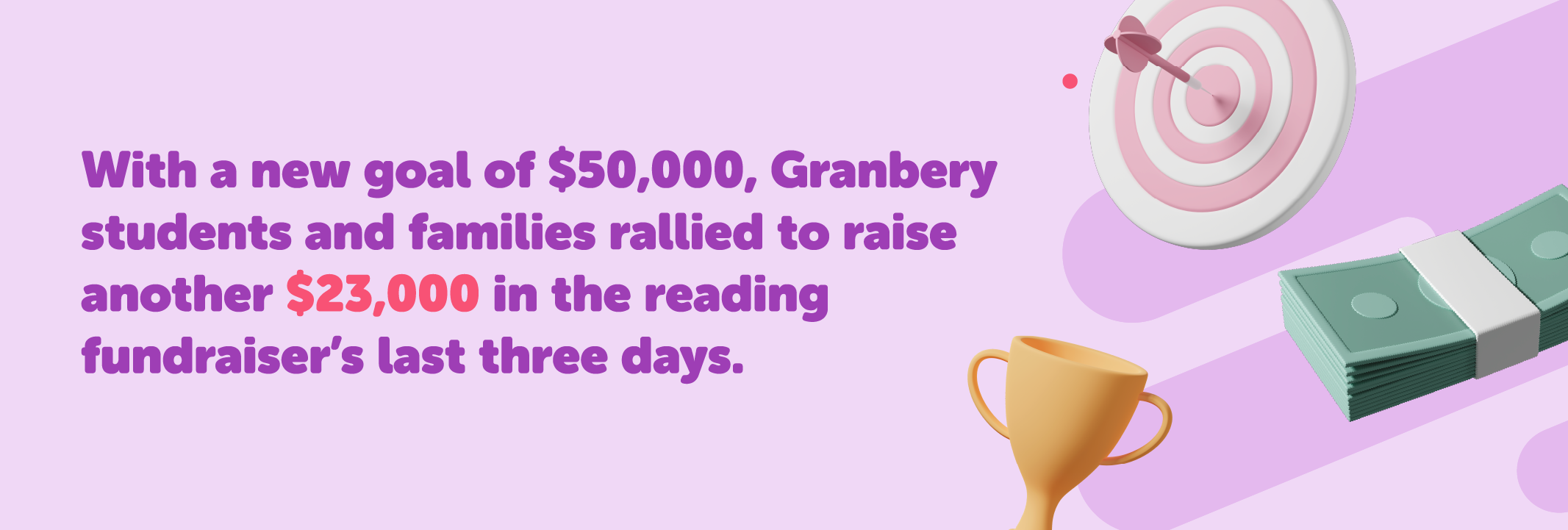With the 2022–2023 school year dawning, the PTA for Granbery Elementary School in Nashville, Tenn., decided to shake things up. Every year, they hold a readathon to fund their events and priorities. But this year, the PTA used Beanstack to run their reading fundraiser. And over the course of ten days in September, they watched their donations tick up and over their goal—twice.
The school hit their initial fundraising target of $35,000 one week into the readathon. But they didn’t stop there. With a new goal of $50,000, Granbery students and families rallied to raise another $23,000 in the reading fundraiser’s last three days. Their final total of $58,034 more than doubled their previous year’s total.
After reveling in the results, we (virtually) sat down with Jordan Turri, the PTA volunteer who ran the reading fundraiser using her expertise as the senior development director at ALSAC/St. Jude Children’s Research Hospital, and Breana Wilkins, the school’s media specialist, to find out the secret to their success.

Streamline for Success
Metropolitan Nashville Public Schools rolled out Beanstack across the school district in 2021 to motivate students to read more with fun and engaging reading challenges. For past readathons, the Granbery PTA tried a number of different platforms, sometimes tracking reading and collecting donations on two different websites. Their fundraiser for the 2021–2022 school year brought in about $22,000.
But for the next school year, the PTA turned to Beanstack to give students, staff, and donors a consolidated, motivational, and user-friendly reading and raising experience. By harnessing gamification technology, reading fundraisers in Beanstack encourage student and staff participation with badges for hitting reading and donation goals, all within an intuitive logging, donating, and reporting platform. Students and families can use one easy single sign-on and share fundraising pages via social media and email directly from the all-in-one platform.
With the switch to Beanstack as Granbery’s new fundraiser platform, the PTA more than doubled their donation total. “It really streamlined the whole process,” Wilkins said. “I’m a parent as well … so I could easily share with my friends and family, through Facebook, through message, all the different ways. And then when I actually gave money, it took me less than a minute.”
“If you have a donor going into a website, you have about two minutes for them to donate, or you lose them,” Turri said. “Having it in one place was crucial. It was also just really easy to work the website.”
Make a Personal Connection
Using Beanstack’s reading fundraiser platform also highlighted and deepened the personal connection between donors and their Granbery students. Not only is it quick and easy to search for and donate to individual students, but they each have their own personalized donation page. Students’ pages display a custom avatar or photo, the books in their reading log, their individual progress, and the school’s overall progress in the readathon. Plus, donors and sponsors can leave heartwarming public messages along with their donation to root on their students.
“I really loved to be able to see all those cute comments, like from a grandma saying, ‘Keep it up! We’re proud of you!’” Wilkins said. “The parents who are donating love to leave a little note like that.”
“They got the ‘warm and fuzzies’ from being able to see the books [read], which is super cute, and being able to see the kids’ pictures—I love that,” Turri agreed.
Coach Your Fundraisers
Turri and Wilkins went beyond flyers and posters to promote their fundraiser. They got specific and shared concrete instructions with staff and families to maximize their impact and minimize confusion and effort.
A few weeks before the readathon started, they shared an overview of the readathon events, prizes, and expectations with teachers, as well as a quick, at-a-glance timeline of all the teacher actions. The teacher resources also included pre-written text for classroom teachers to copy and paste into newsletters and other parent communications. Wilkins sent out how-to videos and did mini Beanstack trainings at teacher planning meetings to make sure teacher participation was high.
In their promotion to families, Turri and Wilkins again made sure to keep instructions clear. They outlined all the prizes, the individual goal ($50 per student), the overall goal ($35,000 initially), and instructions for participating. They included a page of FAQs and, crucially, a list of concrete fundraising ideas and pre-written share text. Among them was the prompt to individually ask three new people for donations and follow up at least once.
All their promotional documents included a bit.ly URL to their Beanstack page, a QR code to scan for more digital resources and information, and contact information for questions. “Try to give them as much up front as possible,” Wilkins counseled.

Timing Is Everything
Another key to Granbery’s success was their strategic approach to the readathon’s timing—from the big decisions like when to hold the fundraiser to the smaller ones like when to offer prizes.
After holding their readathon in the spring during COVID, the PTA decided to move the fundraiser back to the beginning of the school year. Instead of families, donors, and staff feeling burnt out and ready for summer, the reading fundraiser harnessed the community’s back-to-school excitement.
Granbery launched their reading fundraiser on a Friday and ran it for 10 days, ending on a Monday. Starting and ending their fundraiser on school days allowed them to thoroughly promote the kickoff and final push at school. And collecting donations over two weekends gave families, friends, and far-flung connections time to share and donate.
They were also proactive about timing their prizes to incentivize participation throughout the entire readathon. “I knew that there would be a lull in fundraising in the middle,” Turri said. “So I added an incentive on Friday.” Kids who raised $50 by Friday got a special sweet treat of “Space Rocks” pop rocks. The draw was so strong that the school passed their original $35,000 goal that day—and all the students got pop rocks to celebrate.
Make It an Experience
To hit their record-breaking fundraising total of $58,034, Turri and Wilkins turned their space-themed educational fundraiser into an immersive 10-day experience for students and the wider school community.
“We make it a really fun thing,” Turri said. For their readathon’s kickoff, they held a “Space Jam” community movie night. “There was a spaceship in front of the school with a barometer on it that we would change at different levels. There was a space theme in the lobby,” she recounted. The PTA also set up a space themed face in the hole photo station for parents to use when creating fundraising social posts. The school held dress up spirit days on the first Monday and second Friday of the readathon to keep kids invested.
From Turri’s wealth of fundraising experience, she knew that offering exclusive experiences as prizes can really up the ante. So they set up space-themed experiences for hitting key fundraising milestones. Turri strategically ramped up the donation levels for the prizes based on past fundraising data and their new fundraising goals. “We’re always thinking that we’re going to have a similar percentage of who participates,” she explained, “but if I could get those people to give more or get more, that would be key.”
At $50 raised, kids got to spray the principal, the school librarian, and the school mascot with silly string. Then, the PTA turned the gym into a “space rave,” and kids who hit $100 had a dance party. At $150, students could attend a pop-up planetarium at school. And if they raised $200, students won a VIP space demonstration at the local science center.
To ensure that the big fundraisers didn’t stop there, though, they gave gift cards and bluetooth speakers to the top individual fundraiser and top fundraiser for each grade, and an ice cream party for the top class. And to keep all the kids motivated, they rewarded reading effort with daily participation raffles, a gift card for the top reader, and a prize drawing for all students who read at least 20 minutes a day—for which nearly half of their student body qualified.
Fundraising and Reading Success
Granbery’s streamlined system, emotional connection, clear promotion, well-timed campaign, and strategic levels of experiential prizes made a big impact, and in more ways than just their impressive $58,034 total. The reading fundraiser really got kids reading. Out of their 680 students, 86% participated in the reading fundraiser. And the average student logged 32 minutes a day, adding up to a total of 189,650 minutes in just 10 days.
“Everyone loved using Beanstack this year,” said Turri. “I got so much great feedback from donors and teachers.” Wilkins agreed. “We really had such a great readathon, and I contribute most of that to the experience at Beanstack.”
Interested in hosting a reading fundraiser at your school, public library, or school district? Contact our team today to get started.
